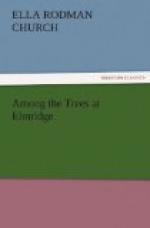“There, Clara!” said Malcolm; “you see now why people cut down hickory trees. The nuts are nowhere, with all these other things.”
“We have finished the walnut family,” said Miss Harson, “but there is a tree that I wish to speak of here because of its long pinnate leaves, which appear to connect it with the walnuts and hickories. This is the ailanthus, a large tree which you have often seen in the village, and which used to be popular as a shade-tree. It is very clean-looking, for the only insect that will eat its leaves is the silkworm.”
“Oh, Miss Harson!” exclaimed the children. “Are there real silkworms on ’em? and can we see ’em?”
“Why, do you not remember our talk about silkworms?” replied their governess. “I am sure I told you that they would not live here in the open air, but they do in China; and the ailanthus is a Chinese tree. It was planted in Great Britain over a hundred years ago for the express purpose of feeding silkworms, because a species of silkworm which was known to be hardy and capable of forming its cocoons in the English climate is attached to this tree and feeds upon its leaves. It was not successful, however, for silkworms, but as a stately and ornamental tree with tropical-looking foliage it was much admired. The ailanthus is quite common in this country as a wayside tree. It possesses a good deal of beauty, from the size and graceful sweep of its large compound leaves, that retain their brightness and verdure after midsummer, when our native trees have become dull. These leaves have nine or ten leaflets as large as a beech-leaf.”
“Isn’t that the tree that smells so in summer?” asked Clara, with a disgusted face.
“Yes; the greenish flowers have a particularly disagreeable odor, which is very strong and penetrating, and this is probably the reason why the tree has lost favor in so many places. But this is only during the season of blossoming, and for several months it is a beautiful Oriental-looking tree with every leaf perfect, while nearly all other foliage is more or less ravaged by insects.”
CHAPTER XVII.
SOME BEAUTIFUL TREES: THE CHESTNUT AND HORSE-CHESTNUT.
The nearest trees to the tent, and standing just back of it, were two magnificent chestnuts, now in full leaf-beauty; and Miss Harson and her little flock stood admiring their majestic size and beautiful color.
“These are the handsomest trees yet,” said Malcolm.
“I almost think so myself,” replied his governess, gazing up into the rich green depths, “and I wish you particularly to notice these radiated—or star-like—tufts of foliage. The leaves, you see, are long, lengthened to a tapering point, serrated—or notched like a saw—at the edge, and of a bright and nearly pure green. Though arranged alternately, like those of the beech, on the recent branches, they are clustered in stars containing from five to seven leaves on the fruitful branches that grow out from the perfected wood. Now stand off a little and see how the foliage seems to be all in tufts, each composed of several long, pointed leaves drooping from the centre. The aments, too, with their light silvery-green tint, glisten beautifully on the darker leaves.”




